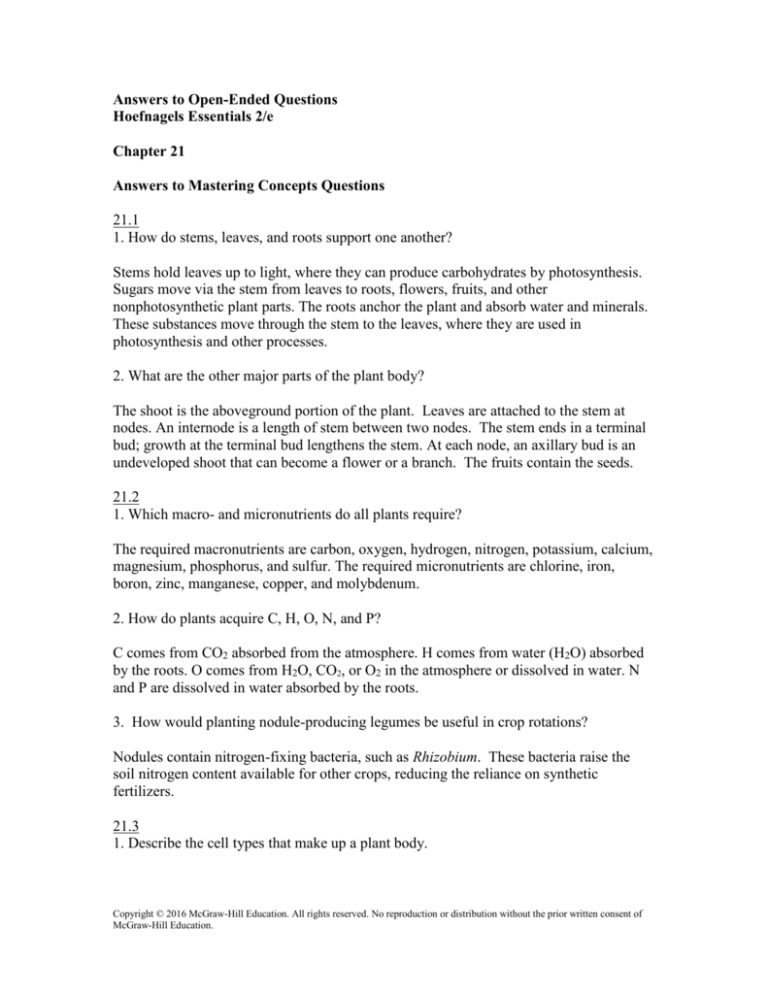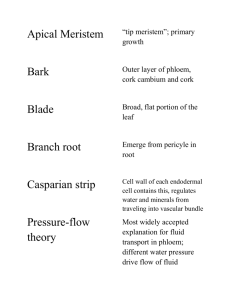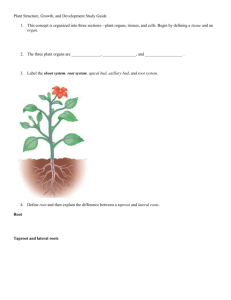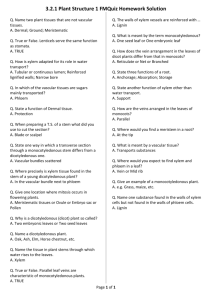
Answers to Open-Ended Questions
Hoefnagels Essentials 2/e
Chapter 21
Answers to Mastering Concepts Questions
21.1
1. How do stems, leaves, and roots support one another?
Stems hold leaves up to light, where they can produce carbohydrates by photosynthesis.
Sugars move via the stem from leaves to roots, flowers, fruits, and other
nonphotosynthetic plant parts. The roots anchor the plant and absorb water and minerals.
These substances move through the stem to the leaves, where they are used in
photosynthesis and other processes.
2. What are the other major parts of the plant body?
The shoot is the aboveground portion of the plant. Leaves are attached to the stem at
nodes. An internode is a length of stem between two nodes. The stem ends in a terminal
bud; growth at the terminal bud lengthens the stem. At each node, an axillary bud is an
undeveloped shoot that can become a flower or a branch. The fruits contain the seeds.
21.2
1. Which macro- and micronutrients do all plants require?
The required macronutrients are carbon, oxygen, hydrogen, nitrogen, potassium, calcium,
magnesium, phosphorus, and sulfur. The required micronutrients are chlorine, iron,
boron, zinc, manganese, copper, and molybdenum.
2. How do plants acquire C, H, O, N, and P?
C comes from CO2 absorbed from the atmosphere. H comes from water (H2O) absorbed
by the roots. O comes from H2O, CO2, or O2 in the atmosphere or dissolved in water. N
and P are dissolved in water absorbed by the roots.
3. How would planting nodule-producing legumes be useful in crop rotations?
Nodules contain nitrogen-fixing bacteria, such as Rhizobium. These bacteria raise the
soil nitrogen content available for other crops, reducing the reliance on synthetic
fertilizers.
21.3
1. Describe the cell types that make up a plant body.
Copyright © 2016 McGraw-Hill Education. All rights reserved. No reproduction or distribution without the prior written consent of
McGraw-Hill Education.
Parenchyma cells: The most numerous cells in the plant body; these cells have thin
primary cell walls and retain the ability to divide and differentiate in response to injury
or a changing environment. These cells carry out major functions such as
photosynthesis, respiration, gas exchange, and storage.
Collenchyma cells: Elongated cells with walls of various thickness providing elastic
support during growth.
Sclerenchyma cells: Cells of variable shape and thick secondary cell walls that contain
lignin, providing inelastic support; these cells are dead at maturity.
Tracheids: Long, narrow, dead xylem cells with overlapping walls that conduct water
and minerals through thin areas in the cell wall called pits.
Vessel elements: Wide, dead xylem cells arranged end to end that conduct water and
minerals through pits and perforated end walls.
Sieve tube elements: Living phloem cells aligned end to end, forming sieve tubes that
conduct dissolved, organic materials.
Companion cells: Living phloem cells that transfer materials into and out of adjacent
sieve tubes.
2. Where in the plant does ground tissue occur?
Most of the body of a plant is made of ground tissue, which fills the spaces between more
specialized cell types inside stems, leaves, fruits, and seeds.
3. Compare and contrast tracheids, vessel elements, and sieve tube elements.
Tracheids, vessel elements, and sieve tube elements are similar in that they are cells that
transport materials within a plant. Tracheids and vessel elements are part of the xylem;
they transport water and dissolved minerals. Sieve tube elements are part of the phloem;
they transport sugars and other dissolved organic substances. Tracheids and vessel
elements are dead at functional maturity; sieve tube elements are alive at functional
maturity. Vessel elements have a wide diameter and have perforated (or absent) end
walls; tracheids are narrow, tapered cells; sieve tube elements have sieve plates through
which strands of cytoplasm pass from cell to cell.
21.4
1. Name the cell layers that occur in the stem of a monocot and a eudicot, moving from
the epidermis to the innermost tissues.
Moving from the epidermis of a eudicot stem toward its center, the tissues are: epidermis;
cortex; vascular bundles composed of fibers, phloem, and xylem; and pith. Moving from
the epidermis of a monocot stem toward its center, the tissues are epidermis; vascular
bundles made of xylem, phloem, and fibers; and ground tissue. Vascular bundles are
arranged in a ring in a eudicot stem but scattered throughout a monocot stem.
2. List the parts of a simple and a compound leaf.
Copyright © 2016 McGraw-Hill Education. All rights reserved. No reproduction or distribution without the prior written consent of
McGraw-Hill Education.
Both types of leaves have a blade, petiole, and axillary bud. Simple leaves have a single
blade while compound leaves have a divided blade.
3. Describe the internal anatomy of a leaf.
Inside a leaf, mesophyll cells are surrounded by air spaces that promote gas exchange as
the cells carry out photosynthesis. Veins contain xylem and phloem, which deliver water
and minerals and carry off sugars produced in photosynthesis. A waxy cuticle covers the
epidermis, and stomata are pores through which gases enter and leave the leaf.
4. Corn is a monocot and sunflower is a eudicot. Make a chart that compares the stems,
leaves, and roots of these plants.
Stem structure: Monocots have vascular bundles that are scattered throughout the ground
tissue of the stem; eudicots have a single ring of vascular bundles in the stem. Leaf
venation: Monocot leaves have parallel veins; eudicot leaves have netted veins. Root
organization: Monocots have a ring of vascular tissue surrounding a central core (pith) of
parenchyma cells; eudicots have a vascular cylinder consisting of a solid core of xylem,
with phloem strands between the “arms” of the xylem core.
21.5
1. What is the difference between determinate and indeterminate growth?
A plant with determinate growth stops growing after it reaches its mature size. In
contrast, a plant with indeterminate growth can keep growing as long as the environment
can support it.
2. What are the locations and functions of meristems?
Apical meristems are located at the tips of roots and shoots; they allow these organs to
grow in length. Lateral meristems (vascular cambium and cork cambium) form internal
cylinders of cells extending along most of the length of the plant. Lateral meristems allow
an increase in girth of woody roots and stems.
3. What are the functions of wood and bark?
Wood, or secondary xylem, makes up most of the volume of a woody root or shoot.
Overall, wood is tough and provides support for the plant. In addition, the sapwood
conducts water and minerals, although the heartwood is nonfunctional. The main function
of bark is to protect the plant; in addition, secondary phloem in the bark conducts
carbohydrates within the plant.
4. Explain the origin of tree rings.
Copyright © 2016 McGraw-Hill Education. All rights reserved. No reproduction or distribution without the prior written consent of
McGraw-Hill Education.
Vascular cambium cells are dormant through the winter, but they divide and produce
wood during the spring and summer. During the wet spring months, the waterconducting cells are larger and the wood is lighter. During the drier summer, the cells are
smaller and form denser rings. The difference in density between spring wood and
summer wood produces visible tree rings.
21.6
1. What are the components of xylem sap?
Xylem sap contains water and dissolved minerals.
2. Trace the path of water and dissolved minerals from soil, into the root’s xylem, and up
to the leaves.
Water and dissolved minerals enter the roots at root hairs. After passing through the
epidermis, the water and minerals may move between or within cells of the cortex. A
waxy strip at the endodermis ensures that all materials enter the living cells of the
endodermis. The water and minerals next enter the xylem and are pulled up the stem and
into leaves. Water vapor moves out of the stomata as part of the transpiration stream.
3. Explain the pressure flow theory of phloem transport.
The pressure flow theory states that phloem moves under positive pressure from sources
to sinks. At a source, companion cells load sugars into the phloem’s sieve tube elements.
Water from adjacent xylem enters by osmosis, increasing the pressure in the phloem.
This increased pressure pushes the phloem sap toward sinks, where sugar is unloaded. At
a sink, water moves out of the phloem by osmosis, keeping the pressure at the sink low.
4. Distinguish between a source and a sink. How can the same plant part act as both a
source and a sink?
A source is any plant part that produces or releases sugars; a sink is any plant part that
does not carry out photosynthesis. The same plant part can act as both a sink and a
source, because a sink may store carbohydrates that are later released to the rest of the
plant.
5. How does a parasitic plant infect and harm a host?
After the seed of a parasitic plant germinates, the seedling secretes an adhesive material
that attaches the seedling to the host. As the seedling’s roots develop, they penetrate the
epidermis and vascular tissue of the host. The parasite “steals” water, minerals, and
sugars from its host; it may also indirectly harm the host by blocking light required for
photosynthesis.
Copyright © 2016 McGraw-Hill Education. All rights reserved. No reproduction or distribution without the prior written consent of
McGraw-Hill Education.
Write It Out
1. When Chris mows the grass, she faces a choice between discarding the clippings and
leaving them on the lawn. How would each choice influence the nutrient content of the
soil? Explain your answer.
If she discards the clippings, then the organic material and nutrients in the clippings are
removed from the ecosystem of her yard. If the clippings stay on the lawn, they can be
decomposed by soil microorganisms, and the nutrients will be released for further plant
growth.
2. If left in the same pot for multiple years, a houseplant may become “root-bound,”
meaning that the roots grow in circles along the inner surface of the pot. Why do rootbound plants eventually show signs of nutrient deprivation?
As roots grow through the soil they absorb nutrients. The densely packed roots of a rootbound plant absorb most of the nutrients in the soil. If the owner does not add fertilizer or
move the plant to a larger pot containing fresh soil, the plant may show signs of nutrient
deprivation.
3. Many biology labs use preserved slides of root tips to demonstrate the stages of
mitosis. Why is this a better choice than using a slide of a mature leaf?
The tips of roots consist of rapidly dividing meristem cells that show all the stages of
mitosis; the leaf does not contain meristem tissue.
4. Thorns, spines, and tendrils are so highly modified that it can be difficult to tell
whether they derive from leaves or stems. How could a biologist use his or her
knowledge of plant anatomy to determine their origin?
The structures would have to be dissected for the examination of internal anatomy. A
leaf should have a leaf epidermis typical of leaves (including stomata), a network of
veins, and some mesophyll cells; a stem should have vascular bundles arranged in a ring
or distributed throughout ground tissue.
5. Predict why it might be more adaptive for a tree to produce thousands of small leaves
rather than one huge leaf.
One possible explanation is that multiple small leaves are more versatile than one large
one. For example, branches can produce new leaves where the light is brightest and
invest less energy in leaves in shaded areas. In addition, if a plant’s single huge leaf is cut
off or damaged, the plant has no “backup” leaves to carry out photosynthesis.
6. Mammals exchange gases in the alveoli of the lungs. How do the structures and
functions of leaf mesophyll compare with those of alveoli?
Copyright © 2016 McGraw-Hill Education. All rights reserved. No reproduction or distribution without the prior written consent of
McGraw-Hill Education.
The mesophyll cells in the lower part of the leaf are separated by air spaces; when the
stomata are open, air can enter and gas exchange can occur across the cell membranes of
the mesophyll cells. Similarly, when the respiratory tract delivers air to the alveoli, gas
exchange can occur across the cell membranes of the alveoli and red blood cells.
7. Girdling is cutting away or severing the living bark in a ring around a tree’s trunk.
Which part of a girdled tree do you expect to die first, the roots or the shoot? Why?
Would the tree be harmed as much by a vertical gash? Why or why not?
The roots should die first, because living bark consists of the phloem that delivers sugars
to the belowground parts of the plant. A vertical gash would not be as harmful because
the phloem would remain intact.
8. The Cork Forest Conservation Alliance is a nonprofit environmental organization
dedicated to preserving the cork forests of the Mediterranean. Visit their website and then
explain to a friend why buying wine closed with natural cork is more environmentally
friendly than buying wine closed with a screw cap.
One argument that natural cork is more environmentally friendly than a metal screw cap
is that cork is a renewable resource, whereas metal is nonrenewable.
9. Suppose you drive a metal spike from the outermost bark layer to the center of a tree’s
trunk. Which tissues does your spike encounter as it moves through the stem, and what
type of meristem produced each type?
The spike will strike the cork, cork cambium (a type of lateral meristem) and a thin layer
of parenchyma. It will then strike the remnants of the primary phloem, which was
produced by the apical meristem. The spike will then encounter the secondary phloem,
vascular cambium (another type of lateral meristem), and secondary xylem. If the tree is
young, the spike may strike primary xylem at the stem’s center; the primary xylem was
produced by the apical meristem.
10. Suppose you use a rubber band to secure a clear plastic bag around a few leaves on a
live plant. What do you think will happen?
Water from transpiration will accumulate in the bag. In addition, the composition of the
gas inside the bag will change: O2 will become more abundant, and CO2 will be depleted.
11. Explain the role of cohesion in xylem transport.
Cohesion is the tendency of water molecules to stick together. As water molecules
evaporate from the leaf, new molecules diffuse in from the vein. Neighboring water
molecules, attached by hydrogen bonds, are pulled up the stem and into the vein. In turn,
water is also pulled from roots into the stem, and from the soil into the roots.
12. How can phloem transport occur either with or against gravity?
Copyright © 2016 McGraw-Hill Education. All rights reserved. No reproduction or distribution without the prior written consent of
McGraw-Hill Education.
Phloem sap moves under positive pressure, which can push fluids with or against gravity.
As sugars enter the sieve tube at sources, water follows by osmosis, creating pressure that
pushes the sap toward sinks (just as a syringe plunger pushes fluid toward the needle tip).
After sugars move into the sink tissue, water diffuses out of the sieve tube by osmosis.
13. Basil is common in vegetable gardens. Many gardeners grow this plant for its leaves,
which provide flavor in sauces and other dishes. Leaf production is higher when young
flowers are pruned off the plant before they have a chance to develop. Explain this
observation.
Plants, like all organisms, have limited nutrients and energy. Flower production requires
sugars and nutrients that could be used to produce stems and leaves. Pruning flowers
therefore increases leaf production.
Pull It Together
1. Which nutrients come from soil? Which come from the atmosphere?
Leaves absorb carbon atoms as CO2 in the atmosphere. Roots absorb all mineral
nutrients, including nitrogen, potassium, and phosphorus, from soil. Hydrogen also
comes from water absorbed from soil. Oxygen atoms may come from water absorbed
from soil or from O2, or CO2 in the atmosphere.
2. Write a phrase connecting water to sugar.
Many answers are possible; here is one. Water moving into sieve tubes produces the
pressure that pushes sugar dissolved in phloem sap.
3. What are the two types of meristems? How do they differ?
The two types of meristem are the apical meristem, which lengthens the stems and roots,
and the lateral meristem, which increases the girth of plants with secondary growth.
4. Add the terms soil, source, sink, pressure flow, and transpiration to this map.
“Roots” connects with the phrase “grow in” to “soil.” “Phloem sap” connects with the
phrase “moves by” to “pressure flow.” “Pressure flow” connects with “explains how
phloem sap is pushed from” to “source”. “Pressure flow” connects with “explains how
phloem sap is pushed to” to “sink”. “Transpiration” connects with the phrase “is the loss
of water through open stomata in the” to “leaves.”
Copyright © 2016 McGraw-Hill Education. All rights reserved. No reproduction or distribution without the prior written consent of
McGraw-Hill Education.









